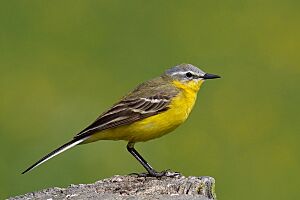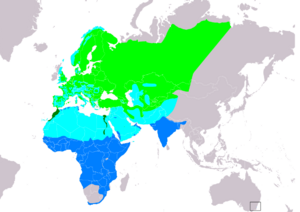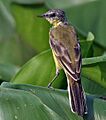Western yellow wagtail facts for kids
Quick facts for kids Western yellow wagtail |
|
|---|---|
 |
|
| Adult male blue-headed wagtail (M. f. flava) | |
| Conservation status | |
| Scientific classification | |
| Subspecies | |
|
Some 15-20, but see text |
|
 |
|
| Range of M. flava Breeding Resident Passage Non-breeding | |
| Synonyms | |
|
Motacilla tschutschensis (but see text) |
The western yellow wagtail (Motacilla flava) is a small passerine bird. It belongs to the wagtail family called Motacillidae. This family also includes birds like pipits and longclaws.
These birds live and breed in many parts of Europe and Asia. Some stay in warmer areas all year, like western Europe. But wagtails from northern and eastern areas migrate to Africa and south Asia for winter.
This bird is slender and about 15–16 cm long. It has a long tail that it wags all the time. This is a common trait for wagtails. The western yellow wagtail has the shortest tail among European wagtails. Adult males are usually olive green on top and yellow underneath. Other wagtails might have less yellow, looking more white. The heads of breeding males can be many different colors. This depends on their specific type, called a subspecies.
The western yellow wagtail makes a high-pitched jeet sound.
This insectivorous bird likes open areas near water. You can find them in wet meadows. They build their nests in clumps of grass. A female wagtail lays 4 to 8 speckled eggs.
Contents
About the Name
The name Motacilla comes from Latin. It means "to move about." People in medieval times thought cilla meant "tail." So, the name became linked to the bird's wagging tail. The word flava is also Latin. It means "golden-yellow," which describes the bird's color.
Different Kinds of Wagtails
It can be tricky for scientists to sort out all the different kinds of yellow wagtails. Many types have been found over time. Today, about 15 to 20 types are seen as real subspecies. The citrine wagtail (M. citreola) is very similar to the western yellow wagtail. They are so alike that scientists sometimes find it hard to tell them apart. Birds from the Beringian region are sometimes called the eastern yellow wagtail (M. tschutschensis).
Some Subspecies You Might See
Here are a few examples of the different types of western yellow wagtails. The colors described are for the male birds.
- M. f. flava – This is the blue-headed wagtail.
- Males have a blue-grey head with white stripes above their eyes and on their cheeks. Females are more greenish.
- They breed from southern Scandinavia to France. They spend winter in sub-Saharan Africa.
- M. f. flavissima – This is the yellow-crowned wagtail.
- Males have a yellow-green head with bright yellow stripes above their eyes. Females are paler underneath.
- They breed in Britain and along the English Channel coast. They fly to Africa for winter.
- M. f. thunbergi – This is the dark-headed wagtail or grey-headed wagtail.
- Males have a dark grey head that goes down to their cheeks. They have no white markings. Females are lighter and more greenish.
- They breed from central Scandinavia to north-west Siberia. They spend winter in eastern Africa, India, and Southeast Asia.
- M. f. feldegg – This is the black-headed wagtail.
- Males have a black cap. Females look like a dull male thunbergi but are yellowish underneath with a white throat.
- They breed from the Balkans to the Caspian Sea. They winter in central Africa.
- M. f. lutea – This is the yellow-headed wagtail.
- Males have a yellow head with a green neck. Females look like a brighter flava female.
- They breed near the Volga River in Russia. They spend winter in Africa and India.
Sometimes, the blue-headed wagtail and the yellow wagtail mix. This happens in northern France. Birds from this area can look different. One type is called the Channel wagtail. It looks like a blue-headed wagtail but has lighter blue on its head. It also has more white on its throat and cheeks.
In Culture
The yellow wagtail was important in ancient Egypt. In their Pyramid Texts, this bird was a symbol of the god Atum. Some people think the yellow wagtail might have inspired the Bennu bird. The Bennu bird is thought to be the inspiration for the famous phoenix in Greek mythology.
Images for kids
-
Adult, probably female dark-headed or north Siberian yellow wagtail (M. f. thunbergi or plexa), wintering in Kolkata (India)












